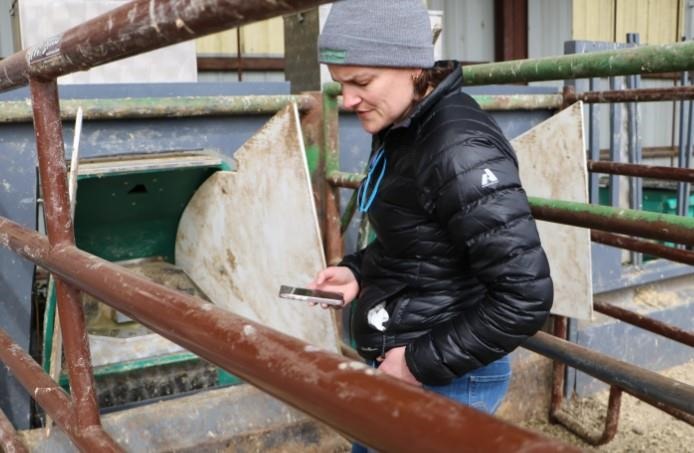By Rae Solomon
A cow gets a snack from a special machine that analyzes the greenhouse gas emissions the animal is emitting at Colorado State University's AgNext climate smart research pens in Fort Collins on March 10, 2023. The cow is part of ongoing scientific research to develop better data on greenhouse gas emissions from animal agriculture, as well as treatments to bring those emissions down.
In many ways, the research pens at Colorado State University are what you’d find on your standard cattle feedlot. There are cows, of course, plenty of mud, and the inevitable, nostril-turning stench of livestock.
But this feedlot, at CSU's agricultural research and education center in Fort Collins, doubles as a scientific laboratory. It's where researchers in the AgNext program - a specialized research group for sustainability in animal agriculture - are learning about the greenhouse gases cows produce as they stand around digesting food. The feedlot is tricked out with millions of dollars of equipment that allow scientists to track everything that goes into each cow, along with some of what comes out.
Specialized feed bins use radio-frequency identification (RFID) technology to track every ounce of corn consumed on a per cow basis. Another piece of equipment called the GreenFeed machine analyzes the gases cattle exhale. It's a bit like a high-tech gumball machine, dispensing tasty cow treats – alfalfa pellets – on a schedule, and at the beckoning of a smartphone app operated by researchers.
On a chilly afternoon in March, Colorado State University Animal Sciences Professor Sara Place demonstrated the technology, tapping a button on her phone. A high-pitched electronic chime sounded and the alfalfa pellets dropped into an opening at cow level, catching the attention of a big-eyed angus who moseyed up for a bite to eat.
“He's got his head stuck in the machine and he's chowing down a little bit of a snack,” Place explained.
Despite common misconceptions about the perils of bovine flatulence, most methane comes out of the cow’s front end in the form of enteric emissions. That means each time an cow gets a snack from the GreenFeed machine, Place has an opportunity to get information.
“The air gets pulled from around the animal's face, and whatever they're respiring out goes directly into the machine,” Place said. “We can get real time methane emissions data from that.”

Methane is a powerful greenhouse gas that has a warming power 80 times more potent than carbon dioxide in the first 20 years of emission. The animal agriculture industry, which includes all operations that raise animals for meat or dairy, produces more methane than any other human activity in the U.S.
Climate experts say we’re running out of time to prevent climate catastrophe. To avoid the worst of it, experts say it is imperative to cut greenhouse gas emissions dramatically before 2030. Environmental groups have ambitious goals to reduce agricultural methane emissions by 30% globally by the year 2030.
But when it comes to emissions from the livestock sector, the science is still just emerging, and it’s not yet clear if the cuts will come in time—or how.
Place hopes to change that with her work in the research pens.
“We want to find solutions that can help mitigate those emissions to cut the climate impact of beef,” Place said.
A tricky proposition
Reducing the climate footprint of beef is a complex problem. According to Kim Stackhouse Lawson, director of CSU’s AgNext program, producing methane is just part of being a cow.
“They're biologically supposed to make methane,” she said.
The gases are the byproduct of a complex fermentation process that happens inside a cow’s largest stomach, called the rumen. Changing that equation involves tinkering with the complex microbiological ecosystem inside a living animal’s stomach, which means there’s still a lot we don’t know.
For instance, there is still no experimental data on baseline emissions from the livestock industry.
“The data is not granular enough,” Stackhouse Lawson said.
Click here to see more...